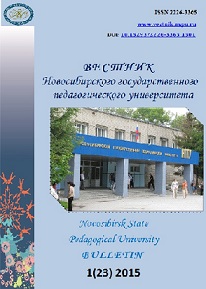МОРФОЛОГИЧЕСКИЕ ИЗМЕНЕНИЯ В ТКАНЯХ ГОЛОВНОГО МОЗГА ПРИ ЭКСПЕРИМЕНТАЛЬНОЙ ИШЕМИИ
MORPHOLOGICAL CHANGES IN BRAIN TISSUES AFTER EXPERIMENTAL ISCHEMIA
Author(s): Farida Temurovna Yаkubova, Kudrat Utkurovich Ibragimov, Muhametamin Mametjanovich Shertaev, Suraye Khakimovna Ikramova, Utkur Kudratovich IbragimovSubject(s): Essay|Book Review |Scientific Life
Published by: Новосибирский государственный педагогический университет
Keywords: an experimental ischemia of a brain; factors of apoptosis; Bcl-2; chromatolis; necrosis.
Summary/Abstract: Discrepancy of the data about neuronal metabolism, factors of apoptosis in brain tissues after ischemia-reperfusion, and also difficulty of evaluation prediction value of rehabilitation ef-ficiency at patients with an insult have determined urgency of problem and expediency of reali-zation of morphological researches at an experimental ischemia of a brain in various terms after reperfusion. Model of brain blood circulation disturbances was reproduced by clipping the right trunk of an anonymous artery for 40 minutes at rats. Morphological investigation was done after 1, 6, 24 hours and 3 and 7 days after reperfusion. Histological preparations studied by light microscopy after hematoxilin eosin treatment, immunohistochemical researches of Bcl-2 was done by “DAKO Citomation LCAB-2” (Denmark). It is established, that at experimental occlusion-reperfusion at brain observed changes are accrue in time after reperfusion. The great-est changes are found out in 6 hours after reperfusion when first attributes of apoptosis were es-tablished. There is reaction of socked formation around neuron by Bcl-2 labeled monoclonal antibodies. At the 7th day there were no apoptosis in brain tissues, but there was necrotic destruction. Necrotic process characterizes with the zone of fusions and independent arrangement Bcl-2 positive cells in the samples. Morphological changes in brain were shown as a hypostasis, chromatolis, which achieved maximal expressiveness at 24 hours after reperfusion, characterized by swelling of neurons, dispersion of tigroid and nuclear basophylia. These attributes are adverse and can be examined as predictors of necrosis, developing on 7 day in brain after occlusion-reperfusion.
Journal: Вестник Новосибирского государственного педагогического университета
- Issue Year: 2015
- Issue No: 1
- Page Range: 72-79
- Page Count: 8
- Language: Russian

